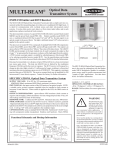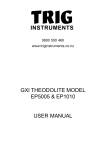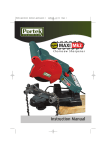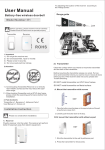Transcript
HOW TO INSTRUMENTS Test and calibrate a Robovector Vector 5 laser WARNING: DO NOT USE THE METHOD DESCRIBED IN THE USER MANUAL TO CALIBRATE YOUR ROBOVECTOR, THAT METHOD RELIES ON ALL YOUR SURFACES BEING PERFECT AND LEVEL WHICH THEY WILL NOT BE! WHEN TO TEST If the Vector 5 gets dropped, knocked or it has been more than 6 months since the last test, it is wise to test the laser using the method below, or bring it in to the Trig Instruments service department for a full factory test and adjustment. There are two ways to adjust the Vector 5 Laser. In our service department we adjust lasers opticaly using a precision range. This is the most precise method. However if the user is careful, they can test and calibrate the laser on site using the method below. the beam parallel on each side. Remove the key after each adjustment, then go back to the beginning of the procedure to test if you have made the adjustment in the right direction and by the right amount. If not, repeat by adjusting anticlockwise. This axis is in adjustment when the gap between your mark “A” and mark “B” are the same at each end of the run. Proceed to “Testing Axis Y” TESTING AXIS Y • After adjusting the X Axis, set the laser up on a tripod or a firm stable surface outside a doorway pointing into a large room. The longer the run the better, up to about 30m • Aim one of the the side beams so that it skims the edge of the door frame and then make a mark in the centre of the beam on the doorframe and do the same where the beam hits the wall. This has now set up two marks that are level with each other (see Fig 2) TESTING AXIS X • Set the laser up on a tripod or a firm stable surface in aproximatly the middle of a run which has a solid vertical surface at each end like a wall. The longer the run the better, up to about 30m each way • Aim the two side beams at the Walls (see Fig 1) WALL 1 WALL 1 WALL 2 ROBOVECTOR LASER BEAM TRIPOD OR BASE DOOR FRAME • At “Wall 1” make a mark in the centre of the beam and label it “A” do the same at “Wall 2” • Rotate the laser 180 degrees and line the two beams up beside the marks you have made • Make a mark at each wall again and label them “B” • Now measure the difference in height at each end • If the heights are the same at each wall then this axis is in good adjustment. If not, proceed to “Axis X Adjustment” AXIS X ADJUSTMENT • On one side of the laser there is a small adjusting screw cap under one of the side windows. Remove this cap and insert the hex-key which was provided with the laser into the small hex-screw inside . Make an adjustment clockwise to this hex-screw to bring www.triginstruments.co.nz FIG 2 - TOP VIEW • Rotate the laser so that the front beam is now skimming the door frame and aimed at the mark on the wall • Measure the difference in height at each end • If the heights are the same then this side is in good adjustment. If not, proceed to “Axis Y Adjustment” AXIS Y ADJUSTMENT • On the front of the laser there is a small adjusting screw cap under the front window. Remove this cap and insert the hex-key which was provided with the laser into the small hex-screw inside. Make an adjustment to the hex screw to bring the beam parallel to the marks made previously. 0800 500 460 © 2008 Trig Instruments all rights reserved FIG 1 - SIDE VIEW









